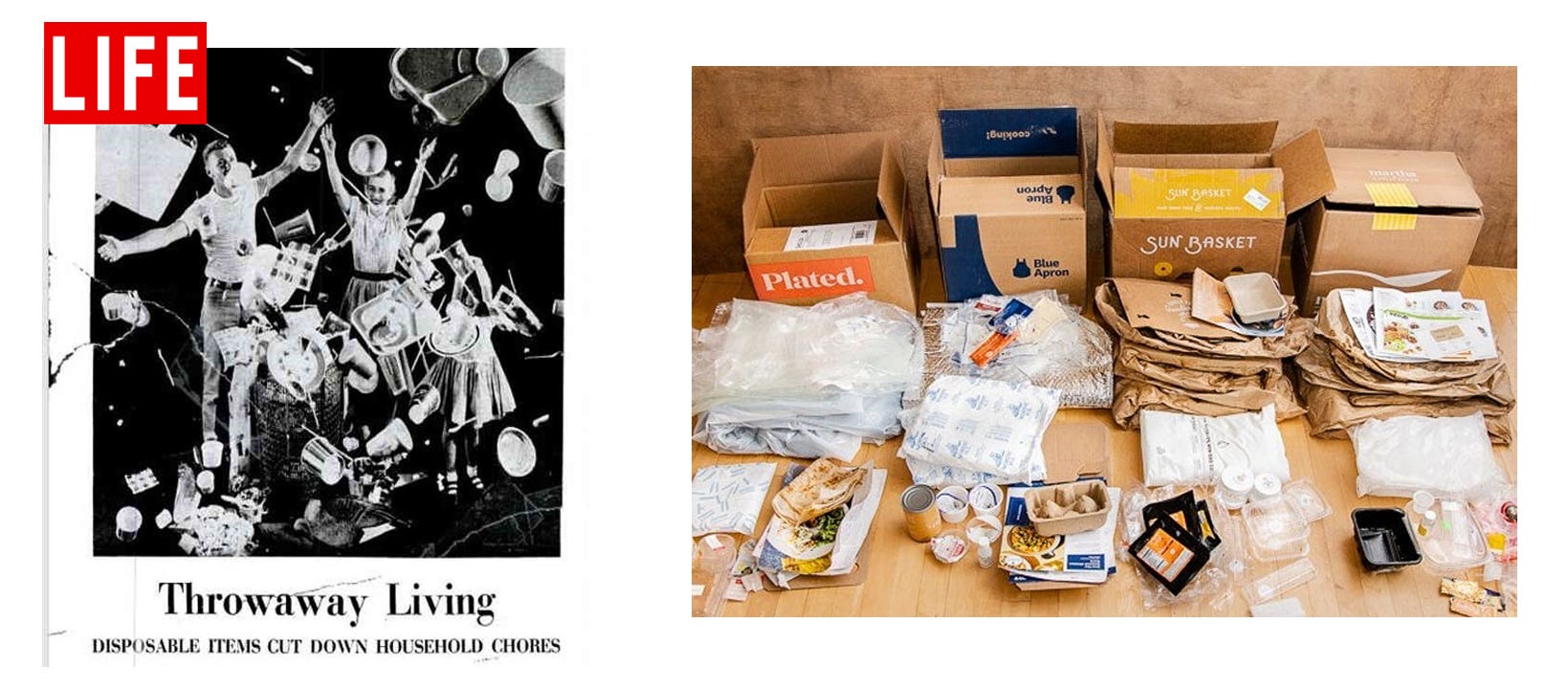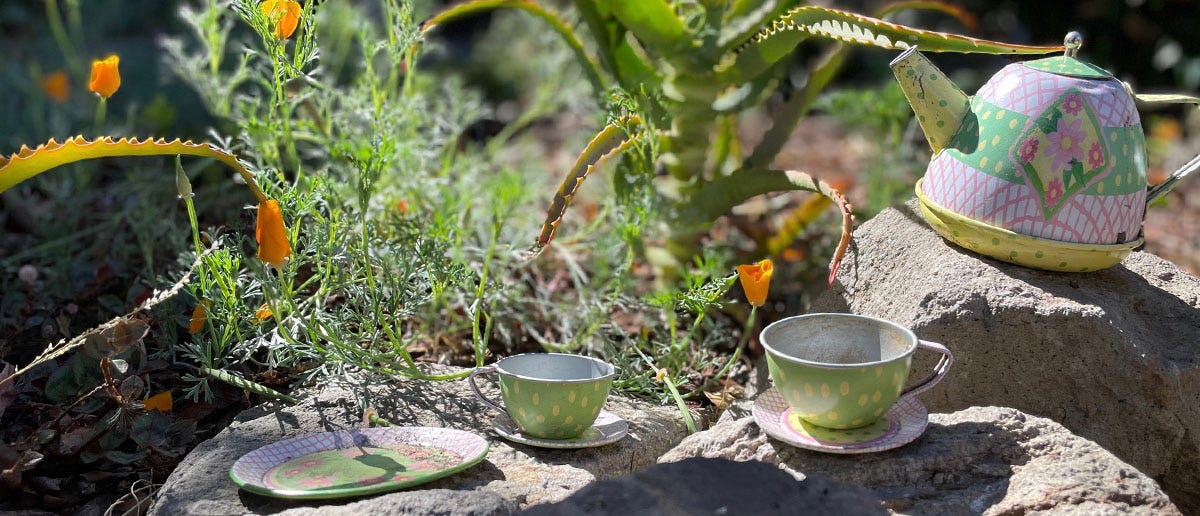Replacing time with trash
Navigating the space between throw-away culture and speculative futures to imagine a more preferable future
When I talk with people about burnout from managing a full-time career, two kids, a dog, a house, and everything in between, the first suggestion is usually always the same. Friends, colleagues, therapists, and coaches all have suggested with excitement “have you looked into those meal kit delivery services?”
In fact, I have looked at many of them - when their coupons show up in my mailbox, ads appear in my browser or HR sends me emails with “perks at work” discounts. Hello Fresh, Blue Apron, Sun Basket, Home Chef, Marley Spoon, and others have populated the market of meal services all claiming to save you time, money, and even the environment. Years ago, when these first started appearing I tried one and was so appalled by the amount of packaging waste in the individualized portions, cold packs, insulated containers, sauces packs, and more that I couldn’t bring myself to order it again. I loathe the suggestion that the answer to meeting the demands of working parents is to generate trash in meal kit deliveries. These kits are only the tip of the iceberg that has translated into many other single-use products and services aimed at solving the problem of time.
Throw-away never actually goes away
The environmental impact of meal kits is complex when you take into account food miles, food waste, packaging, shipping and storage. My focus here is on the throw-away culture that they perpetuate knowing that the vast majority of what we think we recycle, ends up in the trash. Even with the best of designs, minimizing environmental impact and maximizing productivity, we are being sold the idea that time and work demands can solved with a throw-away/ “recycle-away” kit. Not just in the form of meal kits but clothes, kids activities, self care, parties, home goods - you name it, it likely now has an on demand kit service to give you a subscription.

Throw-away lifestyles aren’t anything new. In 1955 Life Magazine published the article Throw Away Living boasting that “no wife need bother” with cleaning when hundreds of new products were being produced to be disposable. The throw-away lifestyle was celebrated in the post-World War II era. Many factories that had been created to make wartime goods were now converted to making household items. Dixie cups, bandaids, disposable maxi pads, tissues, and plastic grocery bags, were all pivots from items made for soldiers. Women who went to work during the war wanted to keep working, leaving less time to cook and clean. TV dinners were an earlier answer to a Hello Fresh delivery box. During the war, there were many efforts to save, conserve, and grow food in your Victory Garden. But once the war was “won”, it was time to spend, consume and throw away with ease! “Disposable” was promoted as everything from more hygienic, easier to clean, more fun, customizable and more. Societal values shifted to promoting happiness and status through consumption. While it’s well documented that this movement was carefully concocted by the plastics industry to encourage plastic and disposable consumption, I can not help but wonder how far into the future the designers, creators, and advertisers of this time thought? Did they think that all the plastic would neatly be disposed of? Did they know that more than 50 years later, all that plastic is still in landfills and not decomposing anytime soon? Or that it would fill out oceans, infect our food chains, and be found in the air? Because throwing something away doesn’t make it go away. It might fill a landfill, pour into the ocean, be burned into the air, or be sent to another country, but it’s still here with us. Was this predicted? Could this have been prevented?
Unintended consequences of band-aid solutions
Someone who did not see where his invention would lead is John Sylvan, inventor of the Keurig machine and its “K-cups”. Designed with the best of intentions - ironically to reduce waste, it has done just the opposite. Intended for office workers who might ordinarily go out to Starbucks for an afternoon coffee (generating the waste of a cup plus lid), a K-cup brewed at the office would instead use a small 1-inch cup. Sylvan now wishes he never invented the K-cup, as it was never intended to be in homes, at people's desks, hotel rooms, dorm rooms, waiting rooms, and every place in between. As I shared in my last post - design goes on designing, we can not always choose how or where our designs go. Once put out into the world, the convenience of the K-cup for office workers went on to be a convenience for many others. A convenience and waste - so much so that there are enough K-cups to circle the earth more than 10.5 times (a statistic from 2014, now likely much higher). Could this have been predicted and stopped?
Of course, meal kit delivery services and even K-cups can be considered a privilege as not everyone can afford them. With inflation currently on the rise, food costs up, and supply chain shortages, we’ve seen reports of people driving less, eating out less, swapping produce, and scaling back on expenditures. The driving force behind these decisions for many is cost and not always environmental impact. Although sometimes it can go hand in hand, such as the report of reusable period products increasing since supply chain shortages have made tampons harder to get. In these shifts, I can not help but wonder if we'll ever go back to the depression-era mindset of saving, reusing, resourcing, and replenishing instead of extraction, excess, and waste.
Oftentimes designers are not looking far enough into the future to understand the impact. In problem-solving, there's kind of a one-step at a time, band-aid-ing through life approach. That could be a microwave meal making cooking easier and faster or disposable plates making cleaning up a breeze. Even the short-term decision to order less take out to save costs is usually only thinking a few steps ahead. What if instead of trying to design forward in these small steps, we instead imagine far into the future. Imagine the world we want to live in 50 years from now, and then design backward, unpacking the steps to get there, designing for the root causes of behind both the environmental crisis and making dinner for your family.
Speculative Design helps imagine the future
Speculative design is a field that tries to make sense of future consequences. The term, most commonly credited to Anthony Dunne and Fiona Raby from their book Speculative Everything, defines it as “an activity where conjecture is as good as knowledge, where futuristic and alternative scenarios convey ideas, and where the goal is to emphasize implications of “mindless” decisions for mankind.” Through the lens of speculative design, we can imagine what our world might be as both utopian and dystopian futures.
Designs for Different Futures, an exhibition organized by the Art Institute of Chicago, the Philadelphia Museum of Art, and the Walker Art Center in 2021 showcased a wide variety of artists imaging futures that range from hopeful to disturbing. Lab-grown food, seaweed textiles, personal gene-editing kits, 3D printed couture, shoes made from sweat, and more explore ideas that will result from our changes in labor, intimacy, power, food, resources, and more. Countryside, The Future produced by Rem Koolhaas, Samir Bantal, and their research/ design studio AMO, for the Guggenheim in New York in 2020, filled the museum with charts, objects, robotic sculptures, images, and videos imagining how our urban lifestyles necessitate an automation of nature and present predictions of a not far off future: hermetically sealed indoor farms, exoskeleton suits to aid farmers, luxury nature escapes, thawing permafrost, political redesign, and others. The all-encompassing systems shown in many ways are not as difficult to imagine as other speculative designers' work that can sometimes look like science fiction. Transfigurations by Agi Haines imagines a world that could be probable given the trajectory of climate change and body enhancements. The work invites the question - could we/ should we alter a baby’s genetic and physical makeup as a way to ‘solve’ living with environmental destruction? Designs for an Overpopulated Planet by Dunne and Raby projects a world where the government and industry can not produce enough food to keep up with the world population, a scenario that some believe is not that far off. Their designs offer modifications to extract nutritional value from non-human foods with synthetic biology and new digestive systems.
All of these works display a paradox of design - while trying to make our environment more efficient, more liveable, and comfortable, we have instead fundamentally destroyed our environment. Speculative design is used to challenge our understanding, and raise questions for debate and inquiry. How might things be? And at what cost? At what cost are we willing to alter ourselves and our communities? At what cost will we make economic, physical, mental, and emotional consequences?
Tensions between future realities and right now
A futures cone is used to depict how we might imagine the future. In the far-off future, what’s probable? What’s plausible? What’s possible? What’s preposterous? In thinking about all of these questions, we can go in two directions - what’s preferable vs what’s not, what’s utopian vs dystopian? Yet, it is useful to look in both directions to keep us moving towards the desirable and be cautious of what is pulling us towards a place we don’t want to end up.
It’s easy to dismiss some of the far-off (or not so far-off) futures I describe above and think that our throw-away meal kits could not possibly lead to physically altering our lungs to accommodate climate change. But it’s not just one meal kit - it’s the resources that went into the food production, the labor to package it and deliver it, the economics that make it accessible or not, the advertising to sell it to us, the culture that has led us to the fast-paced demanding world leaving little time for food preparation all scaled up for mass consumption. Every day we’re presented with a dichotomy of time - imagining preferred futures and the multiple, intersectional design interventions that are needed to move society to get there, while still also needing dinner to feed your family tonight. How do we hold this tension and make sure that we are pulled towards the preferable futures and not lured by products designed to distract us from a bigger picture?
So now it's our turn, to look ahead and imagine the world we want. Imagining scenarios for both global communities and individual families. Instead of designing how to band-aid our current problems with new apps or hot new products generated from throw-away culture, let's start by imagining the communities and environments we want to live in, and design backward from there to support that goal.
What is your ideal community in 50 years? How are you making dinner for your family?





Really appreciate this article, Rachel! Thank you for the thought-provoking work.